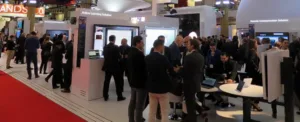In some ways, ISE was a bit disappointing from a display point of view, with no really significant breakthroughs, at least none that we hadn’t seen before. Of course, on the other hand, there were a lot of really great displays. However, that’s pretty standard for any AV event, these days. There was a time when just having a big bright flat display was enough. No longer. Now products have to be stunning to be noticed.
In LCD, this time, I can’t remember seeing anything really innovative this time, even though I met with some panel makers. Sharp had a frame sequential LCD that was novel, but that was just a prototype. It’s a couple of years since Samsung LCD showed a big bright frame sequential LCD panel, but, as far as we could tell, it never came to market. The battle for thinner bezels seems to have stalled for now, partly because the bezels themselves have become so fragile. (Also, the ‘dirty little secret’ that in more than a 2 x 2 array you need to leave room for panel expansion with temperature limits the practical value of thinner bezels).
Meanwhile, LG was showing its OLEDs, in bending and very thin configurations, but while it remains so sensitive to screen burn, is rated only for 16/7 operation and then only for video, it won’t get beyond a niche.
Projection goes from strength to strength as the glass, metal and vacuum technology is discarded for LED and laser light sources of various types, although the low end will stay with lamps for the moment because of the cost savings. Nevertheless, the long life, filter-change free models with great performance must be attractive for A/V and even for digital signage. I don’t buy into the argument that I have heard from one or two display analysts that ‘projection is dead in digital signage’. I think the good work being done in mapping, mirroring and clever control will continue to make projection an alternative for a lot of applications. Projection cubes continue, with great performance and even less visible bezels than before (at least for Mitsubishi).
LED was everywhere, but there wasn’t a lot of change from last year (or at least from Infocomm where Sony showed the Cledis for the first time). Everybody has been chasing dot pitch, but for the reasons that I covered in a recent Display Daily (What LED Has to Do to Be Truly Disruptive), pricing goes up with resolution, not down with area, so smaller high resolution LEDs simply cost too much for a lot of buyers and there is little hope in the near term of dramatic price drops. So, the quest for smaller pitch is just a bragging and R&D excercise and, given the tough market conditions because of the feeding frenzy around LED (LG and Philips joined in this time), making money is going to be a challenge for a while. We heard from Adrian Cotterill of the Daily Dooh that there were 160 companies from Shenzen showing LEDs at the show! (Our editor, Bob Raikes, was interviewed by Adrian, so if you have 10 minutes and are interested in LEDs and OLEDs at ISE, check it out. Bob Raikes Interviewed at ISE 2017)
Collaboration continues to gather mass, with Cisco and Google joining Microsoft. At the moment, many of the systems still have weaknesses, but many of those will be fixed in software during the next year. Meanwhile smaller vendors who have been working in the area are starting to benefit from the ‘respectability’ given to the area. All the touch technologies are getting better and the big board experiences are continuing to improve. The market should see some good growth!
According to the organisers, the final registration count was 73,413, an 11.7% increase over 2016 and the show continues to grow and strengthen. The fourth day seems to have been accepted now (it was blissfully quiet and a big help to us in getting around) and after adding an extra temporary hall this time (as is done for IBC), the organisers plan to add another next year.
The next ISE will take place from 6th to 9th February, so is unlikely to be any warmer than this year’s snow!

